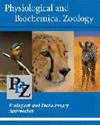十三线地松鼠不同冬眠温度下对环境CO2的通气敏感性
IF 1.8
3区 生物学
Q3 PHYSIOLOGY
引用次数: 0
摘要
进入冬眠的哺乳动物代谢率和体温急剧下降(Tb;至低至热代谢率的~ 2%,温度为1°C至−2°C)。虽然冬眠地松鼠的通气量(V˙E)也大大降低,但它们对吸入二氧化碳增加(二氧化碳增加~ 400%至7%)的相对通气量反应(%ΔV˙E)使恒温松鼠的相对通气量反应(增加~ 60%)相形见绌。根据早期对低温动物的研究数据,我们假设这种表观通气敏感性的转变是状态变化(从恒温到冬眠)的结果,而不是由于核心Tb的变化。因此,我们使用全身容积描记术来评估在20°C、15°C、10°C、7°C和5°C下稳定冬眠的十三行地松鼠的高碳酸血症通气反应(HCVR)。随着结核病的下降,进入冬眠,呼吸模式变得不规则,然后是断断续续的。总V˙E和耗氧量(V˙O2)随Tb的降低而逐渐降低。当呼吸7%的二氧化碳时,核心温度为20°C的冬眠松鼠的V˙E增加了150%,而Tb为7°C的松鼠在暴露于相同的吸入二氧化碳时,V˙E增加了650%。然而,当Tb从7°C冷却到5°C时,HCVR的增加降至450%,并与V˙O2和总V˙E的增加相关。这些结果揭示了呼吸模式和HCVR随着结核的减少而进行性变化,提示冬眠状态的影响可能是结核依赖的。V˙E没有随代谢率成比例下降,HCVR的绝对值和相对值都逐渐增加,直到Tb达到7°C,这两者都可能限制代谢抑制的程度。本文章由计算机程序翻译,如有差异,请以英文原文为准。
Ventilatory Sensitivity to Ambient CO2 at Different Hibernation Temperatures in Thirteen-Lined Ground Squirrels (Ictidomys tridecemlineatus)
Mammals entering hibernation undergo drastic reductions in metabolic rate and body temperature (Tb; to as low as ∼2% of euthermic metabolic rate and 1°C to −2°C). Although ventilation (V˙E) is also greatly reduced in hibernating ground squirrels, their relative ventilatory response (%ΔV˙E) to increases in inspired CO2 (∼400% increase to 7% CO2) dwarfs that of euthermic squirrels (∼60% increase). On the basis of data from earlier studies on hypothermic animals, we hypothesized that this switch in apparent ventilatory sensitivity was the result of the change in state (from euthermic to hibernating) and not due to the change in core Tb. Thus, we used whole-body plethysmography to assess the hypercapnic ventilatory response (HCVR) in thirteen-lined ground squirrels in steady-state hibernation at 20°C, 15°C, 10°C, 7°C, and 5°C. With the transition into hibernation as Tb fell, the breathing pattern became irregular and then episodic. Total V˙E and the oxygen consumption rate (V˙O2) decreased progressively as Tb fell. Hibernating squirrels with a core Tb of 20°C increased V˙E by 150% from normocapnic levels when given 7% CO2 to breathe, while squirrels with a Tb of 7°C increased V˙E by 650% when exposed to the same inspired CO2. When Tb was cooled from 7°C to 5°C, however, the increase in the HCVR fell to 450% and was associated with a rise in V˙O2 and total V˙E. These results reveal progressive changes in breathing pattern and the HCVR with decreasing Tb and suggest that the effects of hibernation state may be Tb dependent. V˙E did not fall in proportion to metabolic rate, and the HCVR increased progressively in both absolute terms and relative terms until a Tb of 7°C, both of which potentially constrain the extent of the metabolic suppression.
求助全文
通过发布文献求助,成功后即可免费获取论文全文。
去求助
来源期刊
CiteScore
3.20
自引率
6.20%
发文量
62
审稿时长
6-12 weeks
期刊介绍:
Physiological and Biochemical Zoology: Ecological and Evolutionary Approaches primarily publishes original research in animal physiology and biochemistry as considered from behavioral, ecological, and/or evolutionary perspectives. Studies at all levels of biological organization from the molecular to the whole organism are welcome, and work that integrates across levels of organization is particularly encouraged. Studies that focus on behavior or morphology are welcome, so long as they include ties to physiology or biochemistry, in addition to having an ecological or evolutionary context.
Subdisciplines of interest include nutrition and digestion, salt and water balance, epithelial and membrane transport, gas exchange and transport, acid-base balance, temperature adaptation, energetics, structure and function of macromolecules, chemical coordination and signal transduction, nitrogen metabolism and excretion, locomotion and muscle function, biomechanics, circulation, behavioral, comparative and mechanistic endocrinology, sensory physiology, neural coordination, and ecotoxicology ecoimmunology.

 求助内容:
求助内容: 应助结果提醒方式:
应助结果提醒方式:


